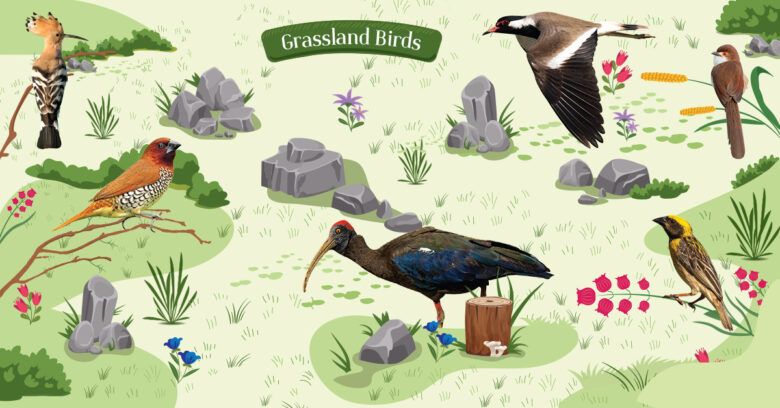Woodland Birds
- Purple-Rumped Sunbird
Scientific Name : Leptocoma Zeylonica
Hindi : Phool-Chuhi (Flower-Rat)
Marathi : Jambhala Suryapaksi.
Like other sunbirds, they are small in size, feeding mainly on nectar but sometimes take insects, particularly when feeding their young. They can hover for short durations but usually perch to suck Nectar from flowers which distinguishes them from hummingbirds.
 Similar but more colorful than the purple sunbird. The male has a metallic green crown and shoulder patch, a dark brown above with metallic purple rump & throat patch, lemon yellow under Parts, whitish flanks, even in non-breeding plumage.
Similar but more colorful than the purple sunbird. The male has a metallic green crown and shoulder patch, a dark brown above with metallic purple rump & throat patch, lemon yellow under Parts, whitish flanks, even in non-breeding plumage.
When the flowers are too deep to probe, they sometimes pierce the base of the flower and rob the nectar, an action termed as “nectar theft” since the flower’s primary purpose of attracting pollinators is foiled.
2. Indian Grey Hornbill (IGH)
Scientific Name : Ocyceros Birostris
Hindi : Dhanchidi
Marathi : Dhanesh
IGH is wide-spread resident bird found across India, except in the southern Western Ghats and in the dry North-Western parts of India. You can easily sight them flying over Within TMF anytime in a day.
With a brownish-grey body, a long black-and-white tipped tail, and red eyes, it has a Signature heavy curved blackish-yellow beak surmounted by a casqued (deleted) over their bill that looks like a Horn, thus the name “Hornbill”.
 They mainly feed on large fruiting trees, (including fig, and seals its nest with its own excreta that has fig seeds, thereby propagating the tree and playing an essential role in the eco-system as prime dispersers of seeds) also known to take mollusks, scorpions, Insects, reptiles and small birds in their diet.
They mainly feed on large fruiting trees, (including fig, and seals its nest with its own excreta that has fig seeds, thereby propagating the tree and playing an essential role in the eco-system as prime dispersers of seeds) also known to take mollusks, scorpions, Insects, reptiles and small birds in their diet.
These gentle giants are threatened primarily by habitat loss in the city and the cutting down of large trees, which is important for both food and nesting. We must protect the natural heritage of our city by conserving these old beneficial trees around our houses and avoid planting ornamental ones.
3. Asian Koel
Scientific Name : Eudynamys Scolopaceus
Hindi : Koel is Delivered from the Sanskrit Word Kokila.
Marathi : Kokil
Asian Koel Is A Member Of The Cuckoo Order Of Birds. Mainly Resident, Widespread – Arboreal Bird.
The Vedas, Sanskrit literature dated to about 5,000 B.C. referred to it as “Anya-Vapa” which has been translated as “that which was raised by others” or (“sown for others to reap”). This has been interpreted as the earliest knowledge of brood parasitism as female lay it’s single egg in the nests of other large birds, including crows.
 Ruby-red eyed with long and broad tail, the adult male is glossy black with dull lime-green bill & female is brown above, spotted and barred with white and white below, strongly barred with dark brown.
Ruby-red eyed with long and broad tail, the adult male is glossy black with dull lime-green bill & female is brown above, spotted and barred with white and white below, strongly barred with dark brown.
They are habitual of keeping themselves concealed in dense foliage when not feeding. They are silent in winter, thus often overlook and recorded as absent.
The bird is widely used as a symbol in Indian & Nepali poetry. It has been chosen as the state bird by the Indian union territory of Pondicherry.
4. Red-whiskered bulbul
Scientific Name : Pycnonotus Jocosus
Hindi : Kala Bulbul, Bulbuli, Guldum
Marathi : Lalbudya Bulbul
The Red-whiskered bulbul is a member of the bulbul family of passerine Birds. It is a resident breeder in tropical Southern Asia from India to Sri Lanka, also Burma and south-western China.
Brown above, white below with a broken or complete breast band. They have a black erect crest, red “whisker” patch behind eyes, white patch on lower ear-coverts and red patch under root of tail are distinguishing features. They are more often heard than seen.
 Young birds are fed on caterpillars/insects which are replaced by fruits and berries as they mature. The life span is about 11 years. The courtship display of the male involves head bowing, spreading the tail and dropping wings.
Young birds are fed on caterpillars/insects which are replaced by fruits and berries as they mature. The life span is about 11 years. The courtship display of the male involves head bowing, spreading the tail and dropping wings.
This species was once a popular cage bird in parts of India. C. W. Smith noted that, “These birds are in great request among the natives, being of a fearless disposition, and easily reclaimed.
They are taught to sit on the hand, and numbers may thus be seen in any Indian bazaar.”
5. Oriental Magpie Robin
Scientific Name : Copsychus Saularis
Hindi : Dahiyar , Saulary (which means a “Hundred Songs”)
Marathi : Dayal
A medium sized robin with a broad white wing bar running from the shoulder to the tip of the wing is a resident breeder often close to human habitation.
Shy & Silent but well known for their clear varied whistling songs, especially during breeding season. The male sings lustily from high exposed perches, chiefly early mornings and late afternoons. Songs are punctuated by upward jerks of white – fringed tail. The black portion of male replaced by Slaty-grey in female.
 The long tail, which is usually held cocked upright when hopping and foraging in leaf-litter on the ground or perch conspicuously. They nest in tree hollows or niches in walls or building and mainly feed on insects and other invertebrates.
The long tail, which is usually held cocked upright when hopping and foraging in leaf-litter on the ground or perch conspicuously. They nest in tree hollows or niches in walls or building and mainly feed on insects and other invertebrates.
Apart from their song, they use a range of calls including territorial calls, emergence and roosting calls, threat calls, submissive calls, begging calls and distress calls. The typical mobbing call is a harsh hissing sound “KRSHHH”.
The oriental magpie-robin is the national bird of Bangladesh; where it is common and known as the “doyel” or “doel” in Bengali. It is a widely used symbol in Bangladesh, appearing on currency notes, and a landmark in the city of Dhaka is named as the Doel Chattar (meaning : Doel Square)
6. Southern Coucal
Scientific Name : Centropus Sinensis
Hindi : Mahoka
Marathi : Bharadwaj, Kumbhar Kaola, Kukkudkumbha
The Crow Pheasant, now more commonly called the “Southern Coucal” resembles a cross between a crow and a pheasant which does not belong to the Crow family, but is a large bird belonging to the Cuckoo family.
 Terrestrial and One of the Non-brood parasitic cuckoos. It has largely black with distinctive rusty wings, a long and heavy black tail and red eyes.
Terrestrial and One of the Non-brood parasitic cuckoos. It has largely black with distinctive rusty wings, a long and heavy black tail and red eyes.
They are most active in the warm hours of the morning and in the late afternoon. They are weak fliers but hops with agility amongst branches or walking on the ground in search of food.
The bird is associated with many superstitions and beliefs. The deep calls are associated with spirits and omens. In British India, it was noted that new-recruits to India often mistook it for a pheasant and shot it to find it “evil flavored” giving it the nickname of “Griff”s pheasant”. The flesh was once eaten as a folk cure for tuberculosis and pulmonary ailments.


